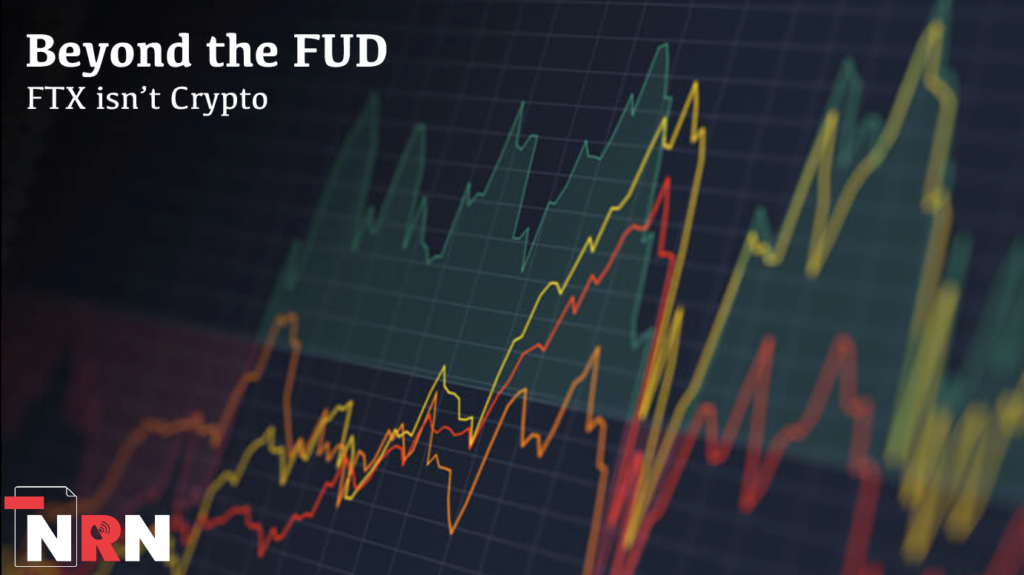By Crypto Canuck and Crypto Crier

FTX isn’t crypto! This can’t be stated frequently or loudly enough! SBF and his band of shysters have been all over the news. The Crypto exchange and its native token FTT have many shell shocked investors wonder WTF happened.
Let’s start with the basics, FTX did not have its own blockchain. It didn’t create, it didn’t program. They were simply some math loving nerds making increasingly riskier bets using Other People’s Money (OPM).
In the early days the bets paid off and they made some money. Ok, a lot of money. However, their luck which they mistook for skill, soon ran out. Remember, when making bets, the house always wins! Those big Vegas Casinos weren’t build by gamblers being successful.
Call for backup
Money (our current “go to” medium of exchange) started essentially as an IOU for precious metals. 1 GBP used to be worth literally one pound of silver. Given current market value of about £205, it is fair to say, it has lost its peg.
In the US, Richard Nixon really messed it all up in 1971. Many books have been written on this subject. The TLDR is up until this time $35USD could be exchanged for 1 ounce of gold. Functionally, goods were priced in either gold or silver. It was just easier to carry around a few bank notes rather than a pocket full of bullion.
Governments get elected by spending money they do not have, which is a problem. Earning in the old fashion way was too slow and hard. Why go through all the hassle of mining your own gold when you can just make some shit up? So, as governments often do, they invented a way to take a shortcut.
Fiat! Money backed by nothing but the government’s good word and ability to tax their citizens to the brink of death (and beyond).

Enter the mysterious Satoshi Nakamoto. Satoshi published a paper “Bitcoin: A Peer-to-Peer Electronic Cash System” in 2008. This paper is often credited with bringing popularity and validity to cryptocurrency. He proposed a decentralized approach for transactions using ledgers, a network, Merkle roots and trees, timestamps, incentives, cryptography, and a consensus mechanism (proof of work).
This is a mouthful for sure, but the important factor was it was a trustless system. It was meant to free the world from rampant corruption of governments, banks and other assorted nefarious intermediaries. Cryptocurrency grew out of Bitcoin. The crypto market is now made up of thousands of coins and tokens.
What’s in a name?
Coin or token? What’s the difference? Well, a whole lot, and it all begins and ends with control. A coin is the native currency of a blockchain. It is spent when signing a transaction or sending funds. The general purpose for it is to be used to facilitate movement and changes made to the blockchain. To create a coin, you must first create a blockchain (you need to actually build something useful). We talked extensively about this in our article on Layer 1s. When you are investing in a Layer 1, you are usually buying a coin. Eth and BTC are examples of coins.
A token is built upon a Layer 1 blockchain. Tokens are used more as a form of stock, loyalty points or voting rights within an ecosystem built upon the chain. A coin allows for control, a token you rely on someone else for control. Take USDC for example it is run by Circle and since they are the owners of the smart contract they can and have frozen user assets with a black list function.
Tokens are quick and easy to create. Most are backed by nothing more than a picture of a dog or some other imaginary thing, just like modern fiat. FTX decided to create its own token (FTT), to add to the illusion of its legitimacy.
Exchanges
Unlike blockchains, coins and tokens, Crypto Exchanges are not products. They are marketplaces more akin to a bank or brokerage firm. Exchanges are divided into two basic categories: Centralized Exchanges (CEX) and Decentralized Exchanges (DEX).
Some of the most well known CEX include Binance, Coinbase, Crypto.com, and of course, FTX. As for the DEX, some popular ones include Uniswap, Sushi Swap, and Pancake Swap. We covered some of the mechanics of DEX in our piece on Vampire Liquidity .
The TLDR on CEXes and, more specifically, FTX (FTT) is they were simply taking OPM (deposits) and making leveraged investments with these funds. Co-mingling your trader funds and user funds with poor accounting allowed them to commit massive amounts of fraud while positioning themselves as the closest entity to the SEC.
Crypto reserves
Our fiat system went to shit when the currencies were no longer backed by precious metals. With no reserves required, governments went on spending sprees. Kinda like how SBF and his friends “borrowed” $1.6B from FTX to buy extravagant houses and vacation properties.
So what exactly are “reserves” anyway and why are they important? When you deposit crypto (or money) into a CEX (or similar investment vehicle), they are taking custody of your assets. The CEX then partakes in various activities to leverage your funds, along with a plethora of other customer’s funds to try and make themselves a profit. This pool of assets they have collected becomes their reserves. For most CEX these reserves are in the billions of dollars.
Spreading the profits
Profit is often measured in what is called a spread. A spread is the difference between what they make on their investments and what they pay you (the investor) as a return. In traditional banking, this takes place with savings accounts and mortgages.
You deposit money in a savings account, the bank now has custody of your funds. In exchange for you doing this, the bank pays you a return, say 3% interest on your deposit. The bank then turns around and loans the money out to someone else in the form of a mortgage and charges that person 6% on the mortgage. The spread is the difference between the two, aka the bank’s profit is 3% (6%-3%) on the money.
What companies choose to do with their reserves is where ne’er-do-wells like SBF get themselves into trouble and lose OPM. With higher risk comes higher reward and vice versa. The amount of a spread they are seeking determines how much risk they are taking on.
Warning signs
When we covered the Celsius Death Spiral we explored how they would entice deposits from investors with what seem like high returns.

In these scenarios, as the liquidity crunch grows, so does the urgency to take on new deposits. Unfortunately these new deposits go only towards old, bad debts. Thus the cycle repeats itself in an ever worsening fashion. Ponzi schemes like these have been taking place for centuries.
A simple question investors need to ask themselves is how much of a spread does the entity I am investing in need to generate to pay me my promised return. With Celsius offering 18.63% returns, they would need to someone be generating in excess of 20% returns themselves.
Not your keys; not your crypto
This should really be written in Sharpie on the back of every degen’s hand. It is so important we both want to offer you separate advice on the topic.
Crier- I have seen this probably 30 times since I started crypto. Small to massive exchanges lose user funds due to mismanagement, fraud, hacks, and other foul means. The only way to combat this is to store crypto how it is meant to be stored; in your own hardware wallet. Cryptocurrency moves too fast and people are too greedy.
Canuck- Web3 assets offer us ownership above all else. Whether coins, tokens or NFTs (yes I get the “T” stands for tokens) we finally have irrefutable proof of ownership. Why be so quick to give that up? Pretty much every crypto hack or bankruptcy has been predicated on investors giving up control of their assets. Don’t do that!
What did we learn?
SBF was a cocky dick. He made brazen bets with OPM while many investors didn’t know they weren’t actually investing in crypto. The beauty of most of this is the FUD happened mostly within the degen echo chamber. Normies got the 15 seconds of headlines and moved on with their own concerns. Rising interest rates means higher mortgage payments and our North American teams all seem to suck at soccer. Combine this with many folks getting a pink slip in lieu of Christmas bonuses you can excuse them for not caring about SBF.
Satoshi would be rolling over in his grave if he saw how the very system he aimed to replace was ruining his great idea. However, the sound principles he helped create continue to live on. Layer 1s are still building. Projects are hiring developer talent as web2 companies are laying people off. If you believe in ownership and blockchain technology as we do, you will find that opportunities are abound. Keep DCAing in ACTUAL crypto and keep your stick on the ice.
